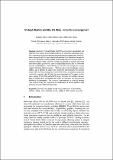Files in this item
Virtual Worlds and the 3D Web – time for convergence?
Item metadata
| dc.contributor.author | Bakri, Hussein | |
| dc.contributor.author | Allison, Colin | |
| dc.contributor.author | Miller, Alan Henry David | |
| dc.contributor.author | Oliver, Iain Angus | |
| dc.contributor.editor | Colin Allison | |
| dc.contributor.editor | Morgado, Leonel | |
| dc.contributor.editor | Pirker, Johanna | |
| dc.contributor.editor | Beck, Dennis | |
| dc.contributor.editor | Richter, Jonathon | |
| dc.contributor.editor | Guetl, Christian | |
| dc.date.accessioned | 2017-06-25T23:35:07Z | |
| dc.date.available | 2017-06-25T23:35:07Z | |
| dc.date.issued | 2016 | |
| dc.identifier | 242951778 | |
| dc.identifier | d492eca6-ddbe-4ca3-9300-6c1f9742afc6 | |
| dc.identifier | 84978946955 | |
| dc.identifier | 000389515200003 | |
| dc.identifier.citation | Bakri , H , Allison , C , Miller , A H D & Oliver , I A 2016 , Virtual Worlds and the 3D Web – time for convergence? in C A , L Morgado , J Pirker , D Beck , J Richter & C Guetl (eds) , Immersive Learning Research Network : Second International Conference, iLRN 2016, Santa Barbara, CA, USA, June 27 - July 1, 2016, Proceedings . Communications in Computer and Information Science , vol. 621 , Springer , pp. 29-42 , iLRN 2016 Conference , Santa Barbara , California , United States , 27/06/16 . https://doi.org/10.1007/978-3-319-41769-1_3 | en |
| dc.identifier.citation | conference | en |
| dc.identifier.isbn | 9783319417684 | |
| dc.identifier.isbn | 9783319417691 | |
| dc.identifier.issn | 1865-0929 | |
| dc.identifier.other | ORCID: /0000-0001-9118-4594/work/126553969 | |
| dc.identifier.other | ORCID: /0000-0003-1209-9063/work/40546710 | |
| dc.identifier.uri | https://hdl.handle.net/10023/11079 | |
| dc.description.abstract | Multi-User Virtual Worlds (MUVW) such as Open Wonderland and OpenSim have proved to be fruitful platforms for innovative educational practice, supporting exploratory learning and generating true engagement. However, when compared with the way educational activities have flourished through the use of the constantly evolving WWW, MUVW learning environments remain a relatively obscure niche. Since the advent and promise of Second Life more than twelve years ago there has been no critical mass reached and no movement towards standardisation. Concomitantly, the 3D Web has emerged as a recognisable if loosely defined concept. With the advent of technologies such as WebGL and a plethora of plug-in 3D viewers for web browsers, the question arises: will MUVWs converge with the 3D Web? If so, can existing educational content be migrated to the 3D Web for mass dissemination? The paper contributes a survey of 3D Web and MUVW terms, concepts, technologies and projects, illustrating their similarities, their value for education and discusses the likelihood of convergence. The survey is complemented by a cultural heritage case study of Unity 3D support for the deployment of virtual worlds in web browsers using two different approaches. | |
| dc.format.extent | 565823 | |
| dc.language.iso | eng | |
| dc.publisher | Springer | |
| dc.relation.ispartof | Immersive Learning Research Network | en |
| dc.relation.ispartofseries | Communications in Computer and Information Science | en |
| dc.rights | © 2016, Springer. This work is made available online in accordance with the publisher’s policies. This is the author created, accepted version manuscript following peer review and may differ slightly from the final published version. The final published version of this work is available at link.springer.com / https://dx.doi.org/10.1007/978-3-319-41769-1_3 | en |
| dc.subject | 3D Web | en |
| dc.subject | Web-based Virtual World | en |
| dc.subject | Multi-user Virtual World | en |
| dc.subject | HTTP/2 | en |
| dc.subject | VRML | en |
| dc.subject | LB2300 Higher Education | en |
| dc.subject | QA75 Electronic computers. Computer science | en |
| dc.subject | Computer Networks and Communications | en |
| dc.subject | Computer Graphics and Computer-Aided Design | en |
| dc.subject | Software | en |
| dc.subject | Hardware and Architecture | en |
| dc.subject | Computer Science Applications | en |
| dc.subject | Human-Computer Interaction | en |
| dc.subject | NDAS | en |
| dc.subject.lcc | LB2300 | en |
| dc.subject.lcc | QA75 | en |
| dc.title | Virtual Worlds and the 3D Web – time for convergence? | en |
| dc.type | Conference item | en |
| dc.contributor.institution | University of St Andrews.School of Computer Science | en |
| dc.contributor.institution | University of St Andrews.Centre for Ancient Environmental Studies | en |
| dc.identifier.doi | 10.1007/978-3-319-41769-1_3 | |
| dc.date.embargoedUntil | 2017-06-25 |
This item appears in the following Collection(s)
Items in the St Andrews Research Repository are protected by copyright, with all rights reserved, unless otherwise indicated.

